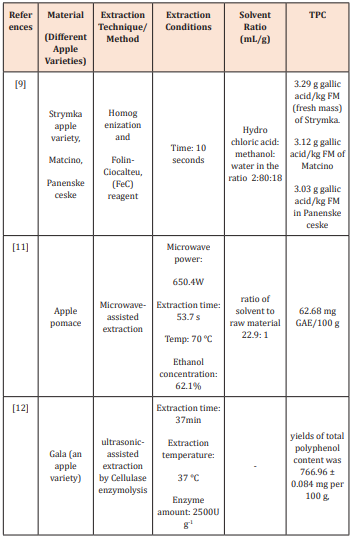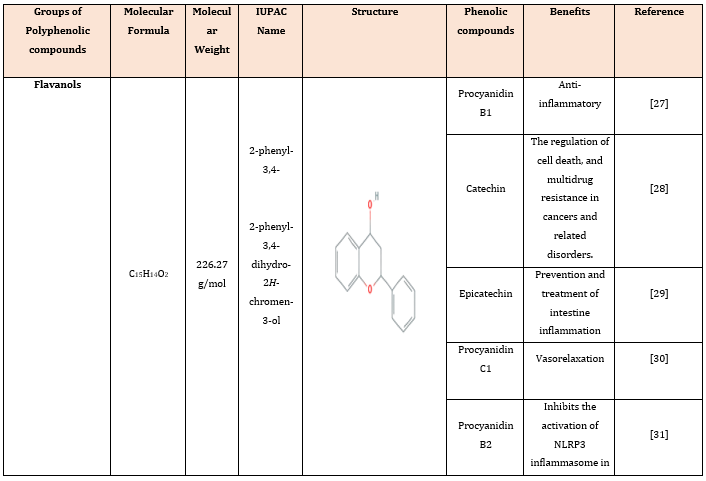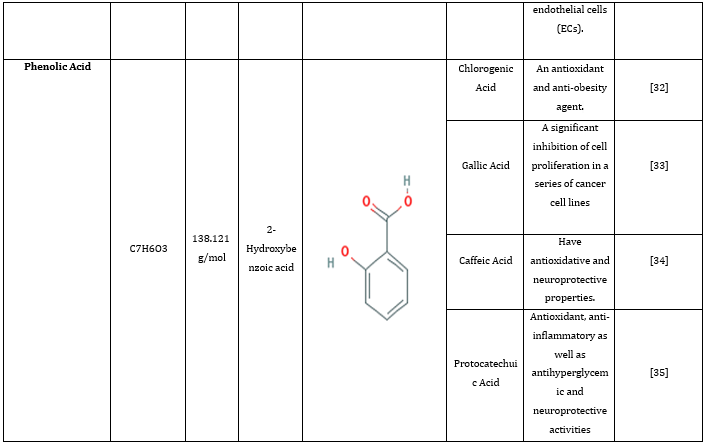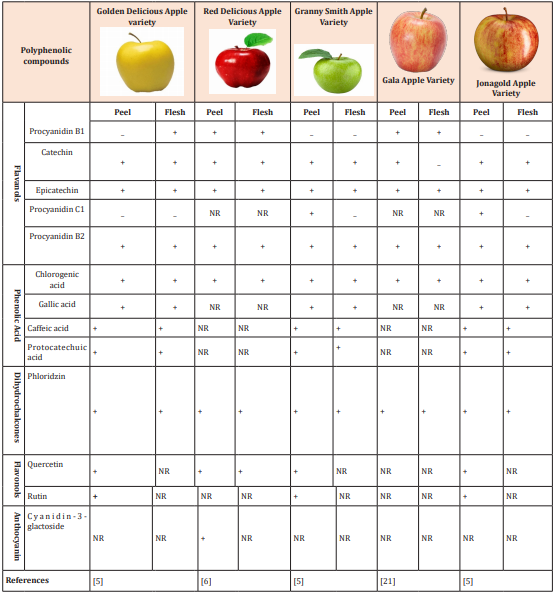Food Science Articles in OAJBGSR
A Critical Review on Presence of Polyphenols in Commercial Varieties of Apple Peel, their Extraction and Health Benefits by Muhammad Modassar Ali Nawaz Ranjha in Open Access Journal of Biogeneric Science and Research_OAJBGSR
Abstract
Apple peel is considered as a waste product in many fruit industries but it is a significant source of various phytochemicals, majorly polyphenols. Polyphenolic compounds are included among the phytochemicals and possess great antioxidant potential. These are the valuable natural compounds possessing a range of biological and chemical properties. Apple peel contains anti-oxidative, anti-proliferative, anti-carcinogenic properties and also have anti-inflammatory properties. Polyphenols are also of great value as they possess free radical scavenging activities. Major phenolics available in apple peel are epicatechin, oligomer, trimer, glycosides quercetin, chlorogenic acid, phloridzin3-hydroxy and procyanidin etc. Polyphenolics are extracted by using different techniques and methods like ultrasound assisted extraction and microwave extraction etc. They also perform a versatile role in disease management like cancer, cardiovascular diseases, diabetes, inflammatory bowel disease, arthritis and many others.
Keywords: Apple peel, Phenolic compounds, Extraction techniques, Phytochemistry, Antioxidant activity, health benefits
Introduction
From centuries, products from natural sources are being used [1,2]. Apple scientifically called as Malus domestica is consumed worldwide. Apple is consumed and easily available around the world and this fruit contains many phenolic compounds [3]. According to Food and Agriculture Organization report in 2011, world apple production was calculated to be approximately 75 million tons. It is of great importance as it possess high level polyphenols and various other phytochemicals.
The polyphenolic compounds have five major groups which are detected in numerous varieties of apple. These include dihydrochalcones, hydroxycinnamic acids, anthocyanins, flavan-3-ols/ procyanidins, and flavanols include catechin, procyanidins or epicatechin [3]. Phytochemicals and flavonoids are also included in these. Flavonoids are of great importance because of their antioxidants properties as they possess high redox potential [4].
Polyphenols present in apple peel are found to be beneficial for human health and is helpful in disease management as it possesses free radical scavenging activities because of their antioxidant property [5]. In many apple varieties, the concentration of polyphenolic compounds along with their antioxidant capacity show variations due to various reasons like environmental conditions, soil content, harvesting time period, and different storage conditions etc. Their concentration in apple does not remain constant [6].
The nature of phytochemicals, its distribution varies between apple peel and its flesh. Apple flesh have catechins, Phloretin glycosides, caffeic acid, procyanidins, chlorogenic acid and phloridzin, however, in apple peel all these phytochemicals are found and additionally it holds flavonoids like quercetin glycosides and also cyanidin glycosides [7]. Their peels are treated as waste product in canned apple industries and apple sauce manufacturing industries due to their hidden potential and health benefits, their utilization should be enhanced [8].
In the United States, major cause of death is due to cardiovascular and cancer related diseases. An apple contains many advantages and is considered good for treating cardiovascular and other diseases [9]. Due to variety of antioxidant properties they reduce the risks of cardiovascular diseases and degeneration processes as these are related to oxidative stress, particularly due to free radicals and specific oxygen species which are reactive in nature [5]. However, apples not only helps to lower the risk of coronary heart disease, but it also lower the risks of diabetes [10].
Extraction of Phenolic Compounds
There are many analytical procedures which has been developed so that we can study the polyphenolic compounds and their specific behavior so that we can know their importance for undertaking the analysis. The design of every specific analytical procedure depends upon the usage and specific analysis [11,12] (Table 1).
Ultrasonic Assisted Extraction (UAE) is novel extraction technology when compared with other conventional methods as it is easy to handle and require moderate concentration of solvent and hence it is economical [13,14]. Major advantage of this technique is that it requires less processing time, produces high yields and it is also environmentally friendly [15]. Microwave assisted extraction (MAE) technique is also widely used as it gives rapid results, is becoming famous and frequently used by analytical chemist for extraction purpose. It is becoming alternative technique as compare to other conventional techniques. It has many benefits as it require less solvent and, in this extraction,, time is also minimum and we can do processing of large number of samples at the same time [16].
Apple peel mainly possesses diverse biological properties and is acceptable as a functional ingredient and is a byproduct obtained after apple processing [8]. Tsao et al., 2003 and Raudone et al., [17] reported that polyphenolic compounds in apple peel are hydroxycinnamates, flavanols, anthocyanins and dihydrochalcones these contributes in antihypertensive activity and in anti-inflammatory activities, , it also possess antioxidant activity [18,19]. These compounds used in fish oil to prevent the oxidation [20].
Table 1: Extraction of polyphenols through various techniques.

Properties of Polyphenolic Compounds
Phytochemicals in Apple
It is observed that cardiovascular problems and risk of cancer diseases are reduced by high intake of fruits and vegetables. Apples are more notable as they contain phytochemical which have their role in reducing oxidation and decreases the chronic diseases. The phytochemical present in apple are phloridzin, quercetin, chlorogenic acid and catechin. The apples are a good source of antioxidants because they contain phytochemicals [21]. Flavonoids are favorably in large concentration found in apple and the concentration of other phytochemical is also present and their concentration depends on several factors like processing of apple cultivation and on harvesting conditions. Procyanidins, epicatechin, catechin, chlorogenic acid and conjugates of quercetin are mostly present in apple peel. Amount of quercetin is also greater in peel than in flesh. So it means that antioxidant property of apple will be greater in peel and lower in flesh [22].
Apple peel is helpful in the inhibition of colon cancer as compared to apple flesh [23]. Epicatechin, catechin and procyanidins have function in reducing LDL and they also have a good antioxidants activity [24]. Similarly, chlorogenic acid contains a strong alkyl peroxyl radical scavenging activity. As alkyl peroxyl radical can promotes tumor and carcinogenesis so chlorogenic acid has its role in the protection against cancer [25]. A strong antioxidant ‘quercetin’ is helpful against heart diseases and cancer. It also has its role in the inhibition of tyrosine kinase and reduce the mutant expression in breast cancer cell. It also reduces the heat shock proteins [26]. Every polyphenolic compound has their own specific health benefit described under (Table 2) [27-39].
Table 2: Phytochemistry of polyphenolic compounds available in apple peel.



Utilization of Apple Peel
1.1. Antihypertensive Properties Of Apple Peel
Apples have sufficient supply of flavonoids containing practicable benefits to health. In North America about 22% of dietary phenolics like flavonoids and phenolic acid are obtained from eating apples [40]. Hypertension is a major problem regarding to health and is increasing day by day in different parts of world. In regard of controlling high blood pressure Angiotensin converting enzyme (ACE) is considered as a major therapeutic target. Latest work shows that apple peel extract rich in flavonoids and its constituents are competitive inhibitors of ACE [41] (Table 3).
Compounds found in apple peel contain anthocyanins and quercetin are useful and advantageous for reducing blood pressure level and have antihypertensive effects [42]. Quercetin component and different kind of flavonoids found in high concentration of an apple peel, lower blood pressure due to its effects like antioxidants, angiotensin-converting enzyme inhibition and improved endothelium function [43]. Pro-anthocyanidins is another component in apple peel that has been studied for its antihypertensive effect. It is beneficial in prevention of oxidation of LDL cholesterol, blood pressure reduction and fat metabolism improvement [44]. Apple now has been identified in several mechanism like lowering of blood cholesterol particularly LDL, weight loss, antioxidant action and prevention of atherosclerosis [41].
It is reported that apple have ability to lower the cholesterol predominately because of presence of phytochemicals like epicatechin, β-carotene, proanthocyanidin-B1 and catechin [45]. Rupasinghe et al. [46] reported that medicinal (pharmaceutical and nutraceutical) methods using apple peel extracts have been derived for treating cardiovascular disease, that lessens cholesterol levels and inhibit low density lipoprotein (LDL) oxidation. Atanassova & Bagdassarian [47] reported that rutin lowers the degree at which mitochondrial damage will occur and improves functions and structure of cardiac mitochondria.
1.2. Antioxidative Properties of Apple Peel Extract
Apple flesh extracts has lower antioxidant actions than apple peel extract [40]. Lipid oxidation, notably oxidation of polyunsaturated fatty acids is prominent issue in the food industry influencing quality of food and health of consumers. Apple peel is considered a natural supply of antioxidant that all components of apple such as quercetin, chlorogenic acid, catechin, and phloridzin are powerful antioxidants. Flavonoids decreases the possibility of cardiovascular disease by increasing the release of endothelial nitric oxide inducing vasodilatation [48].
Anthocyanidins have high antioxidant activity that protects LDL cholesterol oxidation by their action. Peeled and unpeeled apples have high antioxidant activity and suppresses the growth of cancer and helpful in chronic disease prevention. A component pro-anthocyanidins has antioxidant property. It combines with the phospholipids and limits the entrance of oxidants on surface of membrane and restricts the oxidants movement within the membrane [49]. Apple peel has high antioxidant activity compared to the flesh. The peels from an average sized apple have an antioxidant action equal to 820g of vitamin C. Concentration of the phenolics extract is responsible for total antioxidant activity [50].
1.3. Antiproliferative Property
Apple have antiproliferative activity. It is reported that a combination of phytochemical in apple are powerful in blockage of the expansion of tumor cell. Apple has high antiproliferative activity when compared with other fruit [51]. Apple without peel is less effective against Hep G2 cell proliferation than apple with peel. So, it is noted that peel of apple has more antiproliferative activity. Wolfe et.al suggested that peel of apple has higher rate in reduction of Hep G2 cell proliferation as compared to whole apple [52]. It is also seen that the antioxidants of apple is not directly associated in the inhibition of cell proliferation of tumor but they indirectly reduces the cell proliferation [53].
1.4. Anti-Inflammatory Properties
Martín, M. A. & Ramos [54] reported that flavonols such as epicatechin have anti-inflammatory and antioxidant properties and they shows biological effect on target and are chief constituent of human diet. Quercetin have antioxidant property which leads to anti-inflammatory activity and its inhibitory action on enzymes to stop inflammation process with successive inhibition of inflammation mediators like leukotrienes and prostaglandins describe that flavonoid (quercetin) found in apples, red grapes and blueberries have anti-inflammatory properties shown in chronic inflammatory diseases and joint health [54].
1.5. Antidiabetic Property
Apple not only reduces the probability of asthma, diseases related to heart and cancer but it is also noted that eating apple is also related with the low risk of diabetes. It is noted that around 10,000 people who eats apple have lower risk of type II diabetes. As mentioned, quercetin is present in apple in rich amount and its intake help in the reduction of type II diabetes. Apple consumption is also related with increased function of lung and weight loss. Weight loss is noted in middle age Brazilian women by consuming apple [52].
1.6. Ant Carcinogenic Properties Of Apple Peel
Abundance of phytochemicals like catechin, quercetin, chlorogenic acid, and phloridzin are present in apple peel and these considerably act as antioxidants [55]. Triterpenoids isolated from apple peels have strong anti-proliferative activity and might be partly responsible for the apple’s anticancer activity [56]. Rutin is effective against prevention of some cancers and have antioxidant activity like other polyphenols [57]. Biological activity of flavonoids has protective effect in hepatic tumor cells [58,59].
Apples possesses antiproliferative activity against tumor cell growth as well as antioxidant activity that prevents oxidative damage in cellular components [60]. Apple peel instead of apple is used for antioxidant and antiproliferative activity because of high level of quercetin glycosides [38].
Abraham ., et al., Cher et al, and Hall et al., [61-63] describes the antiproliferative effects of apple peel extract increases the maspin expression which inhibits the growth of cancer cells in breast [61–63]. Phytochemicals in fruits and vegetables have synergistic and additive effect that manages their anticancer and antioxidant actions [64]. Interaction of anthocyanins and Proanthocyanidins increases the potency of flavonoid-rich fruits against cancer, metabolic syndrome and cardiovascular diseases [65].
Apple peel constitutes greater quantity of flavonoids, anthocyanins and phenolics and these compounds possess antiproliferative activities [66]. Apple peel have shown strong antioxidant and anti-proliferative activity than apple flesh, specifying that apple peel contains more bioactive phytochemicals. This also gives the idea that presence of high phenolic content, high antioxidant activity and high proliferative activity in apple peel shows that these give health benefits upon consuming and proved to be a valuable source of antioxidants and bioactive compounds [38].
Apple contain larger quantity of biologically active compounds but phenolic distribution in apple peel and apple flesh is different. Both contains chlorogenic acid, Phloretin glycosides, phloridzin but peel have additional flavonoids that are not present in flesh. By evaluating nutritional quality of apple peel contents of phenol, flavonoids and antioxidant activity along with tumor cell growth is higher in peel flesh, regardless of cultivar [67]. Apple extracts from skin and flesh have a dosage-dependent activity which inhibits the proliferation of colon carcinoma and the inhibitory effect was significant in extracts of apple peel [49].
Table 3: Presence and absence of polyphenolic compounds in different Commercial varieties of apple peel and flesh.

Conclusion
Polyphenolic compounds in apple and their specific properties shows great potential in preventing various diseases like cardiovascular, colon cancer, obesity, diabetes and other chronic diseases. They also reduce the risk of carcinogenesis and indicate various mechanisms through which these polyphenols have great beneficial effects on human’s welfare. We can extract them by using many techniques. They also show many valuable effects which includes antiproliferative, anti-carcinogenic and anti-oxidative effects. Thus, a valuable food ingredient can be introduced in the market by using the apple peels if we convert them into dried powder form without losing the polyphenols and phytochemicals and as a result, we can utilize this wastage, can also form many products like pectin etc. and can get many benefits.
More information regarding this Article visit: OAJBGSR
https://biogenericpublishers.com/pdf/JBGSR.MS.ID.00141.pdf
https://biogenericpublishers.com/jbgsr.ms.id.00141.text/
No comments:
Post a Comment